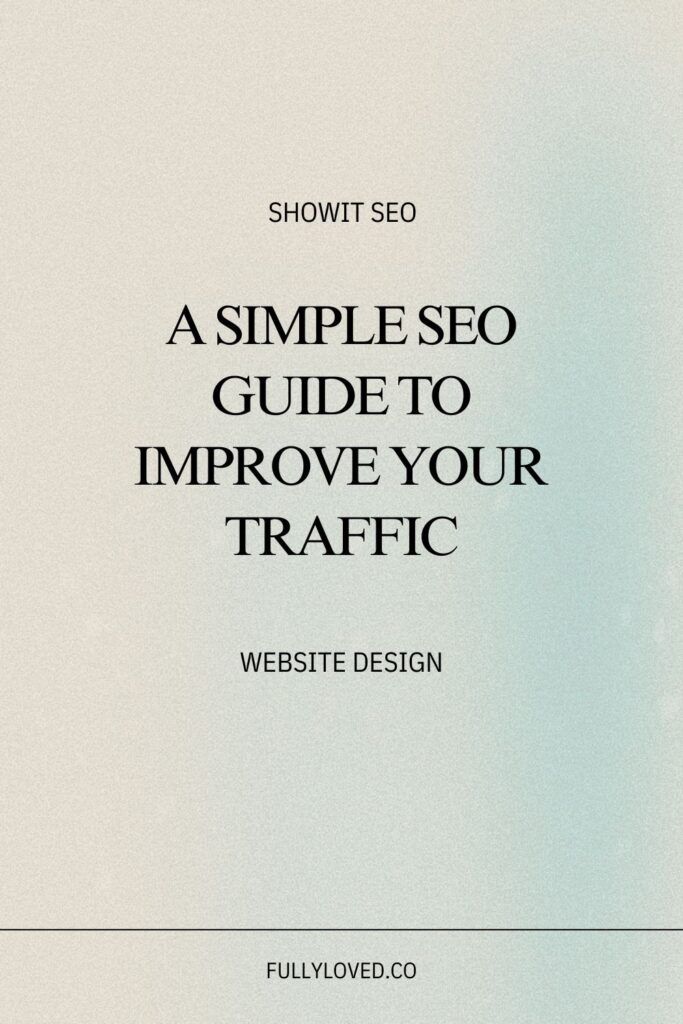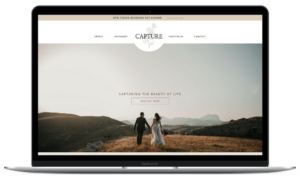So, you’ve launched your shiny new Showit website (yay you!). The fonts are on point, the colors are vibey, and you’re feeling good about how your brand looks online.
But now comes the question every business owner eventually hits:
“How do I actually get people to find this thing?”
Enter: SEO.
I know, I know, Search Engine Optimization sounds like something reserved for tech bros and corporate marketers. But the truth is, SEO is just about helping your dream clients find you on Google when they’re looking for what you do. And lucky for us, Showit makes it way easier than you think.
Let’s break it down, step by step, so you can improve your Showit SEO and get your website in front of the right people, without the headache.
What is SEO and Why Do I Need It for My Website?
SEO stands for search engine optimization — which is really just a fancy way of saying “helping people find you on Google.” It’s what makes your website show up when someone types in keywords like “life coach for newly weds” or “graphic designer for creatives.” Without SEO, your site might be beautiful, but it’s basically hidden in a digital forest where no one’s looking. And if your dream clients can’t find you, they can’t work with you. The good news? You don’t need to be techy to make your SEO work for you — especially with Showit on your side. Let’s walk through the steps that actually matter.
Step 1: Master the Basics of Showit SEO
Before we get into specific strategies, let’s talk about the basics.
Here’s why I love Showit (and why I recommend it to most of my clients): It gives you the creative freedom of a drag-and-drop builder plus the SEO power of WordPress. This means you get the best of both worlds: stunning design and solid SEO capabilities.
Find out exactly Why I Chose Showit for my Business and Love It!
But here’s the catch: as you’re designing your website, you need to keep in mind that beautiful isn’t always what’s best for your SEO. A stunning layout won’t mean much if your site can’t be found in search results. So while aesthetics are 100% part of the magic, we also want to make sure the foundations of your site are set up in a way that helps Google understand what you do and who you serve.
So whether you’ve designed your whole website and SEO is an after thought, or you are on day one of designing your website, the next steps are for you.
Step 2: Use Keywords Wisely on Your Showit Website
Let’s demystify Keywords:
Keywords are just the words your ideal client types into Google when they’re trying to solve a problem.
That’s it. No need to guess or overthink it.
Here’s how to find your keywords:
- Think like your dream client: What would they Google? (e.g. “brand photographer in Melbourne” or “modern Showit website templates”)
- Use a free keyword tool like Ubersuggest or Google Keyword Planner, that help you find keywords with good search volume (lots of people searching) but lower competition (fewer sites competing for that term).
- Focus on long-tail keywords—longer, more specific phrases that are easier to rank for. Think “custom Showit website design for coaches” vs. just “website design.” They’re usually less competitive, making it easier for you to rank.
Once you’ve got your keywords, sprinkle them naturally EVERYWHERE into your:
- Homepage
- About page
- Services page
- Blog content
- Page titles + meta descriptions (more on that next )
Step 3: Optimize Your Page Titles and Meta Descriptions
When you Google something, the blue clickable text and the little blurb underneath? That’s your page title and meta description and it’s SEO gold.
This is what helps Google and real humans understand what your page is about (and decide whether to click).
How to Optimize Page Titles and Meta Descriptions:
- Every page should have a unique title that includes your main keyword
- Meta descriptions should be short, specific, and make people want to click (think: one strong sentence with a keyword)
- Customize it per page. Don’t copy-paste the same one everywhere!
- Use Ai to help optimize. A good prompt goes a long way…
In Showit: Head to the SEO settings for each page, and plug in your custom title and description.
Step 4: Make Your Images Work for SEO
You already know visuals are a big deal in Showit (gorgeous sites are kinda their thing).
But here’s the part most people skip: optimizing your images for SEO.
Google can’t “see” your images—so it relies on text to understand them.
Quick wins:
- Rename your image files before uploading (e.g. melbourne-brand-photographer.jpg not IMG_3724.jpg)
- Add alt text to every image, as this boosts accessibility and SEO
- Compress your files with TinyPNG before uploading so your site stays speedy. Aim for images between 200KB and 300KB
Speed matters. A slow site = lower ranking.
Step 5: Link like a Pro! (Both Internally and Externally)
Think of links as little bridges, connecting content and showing Google how your site is structured.
There are two types:
- Internal links: Link between pages on your own site (like blog to services). Like this one to my post on 6 DIY Website Design Mistakes and How to Avoid Them
- External links: Link to high-quality, trustworthy sites (think: Google SEO resources, relevant industry blogs). Like my affiliate link to a free month on Showit.
Why it helps:
- Google loves seeing content that’s connected and helpful
- It keeps people on your site longer
- It shows your site is part of a broader, trustworthy ecosystem
Warning: Don’t go overboard with external links. One or two relevant ones per page is plenty. And make sure none of your links are broken (aka don’t go anywhere! It’s always good to go back and check old links, too).
Step 6: Write Fresh, Valuable Content (Hello, Blogging!)
I know blogging can feel like one more thing on your already full plate.
But here’s the thing: Blogging is your SEO superpower.
Because Showit uses WordPress for blogging, you get all the SEO tools baked in, without needing to install a bunch of techy plugins.
Fresh content = more opportunities to show up in search.
Tips to make it doable:
- Write blog posts that answer common client questions
- Target one main keyword per post (and use it in your title, headings, and URL)
- Don’t overthink it. Just aim to be helpful
- Post once a month to start (consistency > frequency)
Here are some simple blog starter ideas to get the wheels turning:
- “5 Things I Wish I Knew Before I [insert your service/product]”
- “How to Get Started With [insert what you offer]”
- “What to Expect When You Work With Me”
- “Behind the Scenes of My Business”
- “Top Tools I Use in My Business”
- “Common Myths About [your industry] Debunked”
- “My Daily Routine as a [your role]”
- “How to Choose the Right [product/service] for You”
- “Mistakes to Avoid When [doing something related to your niche]”
- “Answers to Your Most Frequently Asked Questions”
- “Client Story: How We Solved [insert challenge] Together”
- “My Favorite Resources for [your niche or audience]”
Pro tip: Write like you’re answering a question for your dream client. Google wants helpful, human-first content. So harness the benefits of Ai, but don’t get Ai to do the heavy work for you. I can instantly spot a fully Ai generated post, because it usually isn’t researched or written well, it’s missing key info that I am really searching for and honestly, they are usually just all out boring!
Final Step: Track Your Showit SEO Progress
You don’t need to become an analytics wizard, but a quick monthly check-in can tell you what’s working.
Set up these free tools:
- Google Analytics: See how people find and use your site
- Google Search Console: See which keywords you’re showing up for, and fix any technical SEO issues
Then ask yourself:
- What pages are people landing on?
- What keywords are getting the most clicks?
- What blog posts are performing best?
Use that info to create more of what’s working. My best performing content is not usually my favorite content, but it is what my ideal clients are looking for.
Your No-Fluff Showit SEO Checklist:
✅ Choose strategic keywords your audience is actually Googling
✅ Add custom page titles + meta descriptions
✅ Rename and alt-tag all your images
✅ Link between pages and to reputable external sources
✅ Blog monthly (even short posts help!)
✅ Set up Google Analytics + Search Console to track what’s working
Wrapping Up: Your SEO-Boosting Showit Checklist
If SEO has felt overwhelming or confusing up until now, I hope this made you feel a bit more in control.
Check our Fully Loved Showit Templates and get found faster—without starting from scratch.
Boosting your Showit website SEO doesn’t have to be overwhelming. By taking it step by step, you’ll set up a solid SEO foundation that grows your visibility, attracts ideal clients, and ultimately strengthens your business.
SEO isn’t about tricking the search engines; it’s about making it easy for your audience to find you. So, take it one step at a time, keep it authentic, and watch as your Showit site grows into the powerful business asset it was meant to be.
Want an Showit SEO shortcut? My Showit website templates are built with SEO best practices already baked in, so you can launch a beautiful and optimized site in less time.
Discover Fully Loved Showit Templates
You can start your first month free with Showit here (yep, that’s my affiliate link, but I only recommend what I actually use and love).
You may also like: The online business tools and platforms I recommend to run an online business









